Update on the Morton collection
For updates on the Museum’s work towards the repatriation and burial of the Morton Collection, please refer to this page.
Although few visitors to the Museum would know this, the Samuel George Morton cranial collection at the University of Pennsylvania Museum of Archaeology and Anthropology is one of the most famous collections of human skulls in the entire world. Its presence in Philadelphia is the result of the collecting activities of Samuel George Morton (1799–1851), a Philadelphian who actively participated in the vibrant medical and scientific community that spanned the Atlantic Ocean in the early 19th century.
At age 17, Morton began attending lectures at the University of Pennsylvania Medical School. Earning his medical degree in 1820, he became a member of the Academy of Natural Sciences of Philadelphia—an organization with which he would stay closely affiliated for the rest of his life. After returning home from a trip to Europe, Morton began his medical practice in Philadelphia in 1824. A sophisticated and esteemed young doctor, he soon rose to prominence in the local medical community and became a professor of anatomy at Pennsylvania Medical College in Philadelphia.
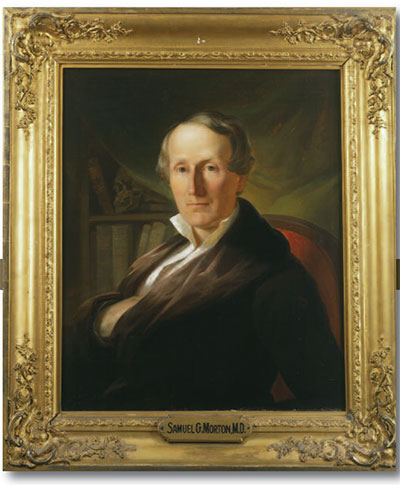
Morton’s special interest in crania may have originated in 1830 during his preparation for an anatomy lecture titled “The Different Forms of the Skull as Exhibited in the Five Races of Men.” Intending to present a lecture illustrated with examples of the skulls of the five racial categories recently developed by the German anatomist Johann Friedrich Blumenbach (1752–1840), he quickly realized he did not have sufficient examples to exemplify each group. This experience served as a catalyst for his lifelong desire to collect crania from all over the world in order to provide examples of as many geographic areas and different cultural groups as possible.
His letters reveal that in 1832 he sent one of his first inquiries to a scientific colleague seeking to obtain crania of various races for his collection. Just one year later, Morton remarked in correspondence that his cranial collection was nearing 100 specimens and included “peoples of many tongues.” Thanks to his genial personality and stature as a member of the Academy of Natural Sciences, Morton was able to correspond with leading scientists all over the world—a key factor in the development of his collection and scholarly contributions.
Amassing the Collection
Morton’s correspondence—now housed in the American Philosophical Society as the Morton Papers—indicates that his worldwide connections included as many as 138 contacts, from scientific colleagues to merchants, military figures, and missionaries. As William Stanton has observed, “His wide scientific correspondence, especially with army surgeons stationed at remote frontier outposts, brought him crania from every state, territory, and nation ….” His contributors were proud to be a part of an important scientific enterprise; one that gained increasing prominence as the years passed. Morton’s collection soon became the largest of its kind in the world and earned the nickname “the American Golgotha” in scientific circles. Indeed, the endeavor was so significant that army surgeons stationed in remote areas of the world would take great risks to obtain crania for Morton, and they were not above robbing graves in order to do so!
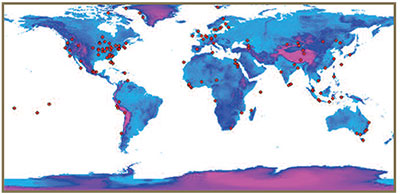
Morton’s success in collecting crania is particularly remarkable in light of his own frail health and limited travel within Europe and the West Indies. His personality, however, garnered him loyal friends, which was an important aspect of his collecting since the integrity of his collection ultimately rested upon their reports of the context from which each cranium came. As Stanton notes, Morton “had to rely upon correspondents for the circumstances of the discovery of a particular skull, its situation in the earth, the geological conformation of the site, and their opinion as to the tribe to which it belonged.”
Each shipment of crania had its own unique story, often connected to dramatic historical events. In her essay, “The Curious Cabinet of Dr. Morton,” Ann Fabian points out how forces such as war and disease helped Morton’s collaborators obtain crania. For example, one man assigned to the U.S. Army in Florida picked over the dead of the Seminole war, sending Morton two “fine” Seminole skulls left unburied after the battle of Lake Okee-Chobee, while another contact happily forwarded Morton the heads of four of the 630 Mexican soldiers killed in 1836 during the battle of San Jacinto fought between troops of the Mexican General Santa Anna and the Texan Sam Houston.
Morton’s Science
Like most of his scientific contemporaries, Morton was a scholar of diverse interests. In the course of a relatively short lifetime he published papers in the fields of anatomy, medicine, vertebrate paleontology, geology, and craniology. For example, his first scientific publication in 1834, Synopsis of the Organic Remains of the Cretaceous Group of the United States, described the fossils collected by Lewis and Clark thirty years earlier. This study was the first of its kind in the United States and solidified Morton’s standing in the Philadelphia scientific community.
In 1839, Morton published his first craniometry book, Crania Americana; or, A Comparative View of the Skulls of Various Aboriginal Nations of North and South America: to which is Prefixed an Essay on the Varieties of the Human Species, which included 71 beautiful lithograph illustrations created by John Collins of Philadelphia. Beginning with an introductory essay on the various races of man, Morton then discussed the crania and customs of the Indian nations. His book concludes with an essay by the renowned phrenologist George Combe, clearly indicating (as Paul A. Erickson has noted) that Morton was heavily influenced in his thinking by the 19th century practice of phrenology (the now abandoned field of study which used the shape of the skull to determine personality traits) and the theories of hereditarianism (a school of thought that saw heredity playing a major role in determining traits such as intelligence and personality) and polygenism (a school of thought that saw human races as created separately and unequal).

The second of Morton’s major craniometry publications, Crania Aegyptiaca, or, Observations on Egyptian Ethnography, Derived from Anatomy, History, and the Monuments, was published in 1844. In this study, Morton extended his analysis of human races to ancient Egypt, claiming that the distinct racial differences shown in modern “Caucasoid” and “Negroid” crania were equally discrete in the past. Thus he advanced the thesis that the ruling elite of ancient Egypt had been “Caucasian,” while the subservient class had been “Negroid.”
As Audrey Smedley has noted, this claim clearly resonated with Morton’s contemporaries, who defended the practice of American chattel slavery. Morton’s belief that enslavement of blacks by whites had roots in antiquity fueled the argument for a natural order of racial hierarchy. In fact, upon Morton’s death in 1851, the Charleston Medical Journal published a memoir stating: “We can only say that we of the South should consider him as our benefactor, for aiding most materially in giving to the negro his true position as an inferior race.”
While influenced by phrenology, Morton did not wholeheartedly embrace it, trusting instead to the scientific measurement of craniometry. For example, his Crania Americana and Crania Aegyptiaca used scientific measurements to provide direct support for polygeny, whereas many of fellow supporters of polygenism applied deductions from philosophy, politics, and religion. In contrast to them, Morton believed that the scientific method and objectivity alone could be used to understand human racial variations. Yet despite the popularity of his work during his time, it did not go unchallenged by contemporary scholars such as Fredrick Douglass.
Morton’s Collection
Morton’s scientific career ended in 1851 with his death at the relatively young age of 52. By then, he had amassed a collection of 867 carefully prepared and labeled human crania, as well as a number of non-human vertebrate skulls. Prior to his death, a number of his friends pooled funds to purchase his collection for $4,000 and then donated it to the Academy of Natural Sciences in Philadelphia.
James Aitken Meigs, a friend and fellow member of the Academy, continued collecting crania for the collection after Morton’s death. By 1872 the collection numbered 1,225 human crania and Meigs published several editions of Dr Morton’s Catalogue of Skulls, as well as a memoir of Morton.
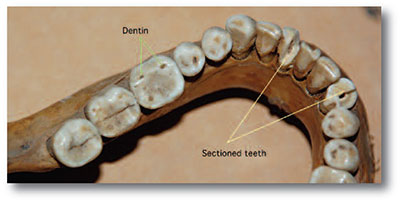
For many years, the Morton Collection was on display at the Academy of Natural Sciences and open to visitors free of charge on Tuesdays an Saturdays. Its fame continued throughout the 19th century and, in 1892 the Academy sent 44 of the Native American crania to Spain for the 400th anniversary of Columbus’s discovery of the New World.
In the mid-1960s, the Academy of Natural Sciences loaned the entire collection to the University of Pennsylvania Museum of Archaeology and Anthropology, later converting it to a gift to our Museum where it resides today. As Ann Fabian describes it: “There they sit, a relic and residue of past science, among a disorderly collection of grinning human skulls. Morton’s skulls stand out. The craniologist varnished each to a high polish, tattooed each with a Roman numeral, and attached to each a small explanatory label.”
Morton’s Place in the History of Science
It is generally agreed by historians of anthropology that Samuel G. Morton was a pioneer in American anthropology and the founder in this country of the sub-discipline of physical anthropology. In his recent discussion of the development of physical anthropology, C. Loring Brace asserts that Morton’s attention to ethnographic context and his use of over 12 cranial measurements to compare geographically circumscribed groups established Morton as a pioneering early scientist of anthropology. Regardless of the controversy associated with his findings on racial differences, Brace credits Morton with developing methods of cranial measurement that are still used today.
Scholarly debate, however, still surrounds the extent to which Morton’s own personal racist beliefs impacted how he both consciously and unconsciously handled his craniometric data. Some insight into Morton’s personal views on slavery can be gained from the journal he kept while traveling in the West Indies in the 1830s. On some days, his observations reflect deep racism, while on others he expresses disgust for the conditions of slavery in the Caribbean. Yet did his personal beliefs affect his science?
In 1981 this debate came into popular focus when Stephen J. Gould published The Mismeasure of Man. This book explored the motives underlying Morton’s influential findings (which provided fodder for others such as Josiah Nott to argue for the superiority of whites). Gould used Morton as an illustration of the impact that a scientist’s personal beliefs can have on his selection of samples, measurements, and analysis of data. Claiming that Morton was a racist who believed whites to be superior to blacks, Gould accused Morton of knowingly manipulating his samples and calculations to show that whites had the largest cranial capacities of all racial groups.
But was this true? In 1988, John S. Michaels, a Penn undergraduate, re-measured a sample of Morton’s crania and found—contrary to Gould’s assertions—that Morton’s measurements of cranial capacities were actually accurate within the practices of his day. There was no evidence to suggest that Morton’s personal beliefs had led him to racially bias his data. He studied the crania he had at hand objectively and scientifically and reported his findings as such. In contrast, as C. Loring Brace has pointed out, it appears that Stephen J. Gould’s portrayal of Morton as a subjectively influenced scientist is, in fact, a clearer example of a scientist selectively choosing his data to support an assertion. Having never bothered to check Morton’s measurements, Gould allowed his own perception—that Morton was a racist and therefore a suspect scientist—to influence his own analysis of Morton’s science!
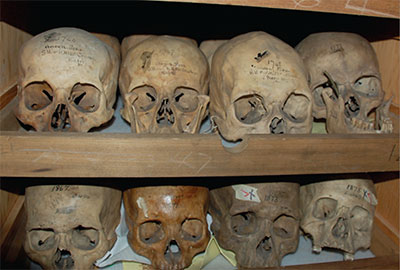
The Morton Collection Now and into the Future
Although no one can doubt Morton’s contribution to the study of crania in physical anthropology or his influential role in the controversial debates surrounding the differences between races (which even today are surrounded in layers and layers of interpretation), his work became less and less timely and more and more obscure (except to historians interested in the development of scientific racism in the United States) as the 19th century faded into the 20th century.
But with the transfer of his collection to the Penn Museum in the mid-1960s, whole new vistas of research have come into focus based upon the unique composition of the collection—a huge comparative set of crania that illustrate human biological variation in the skull from the early to middle 19th century. Dozens of researchers have requested permission to visit the collection and to use the CT scan data we have derived from the skulls. To illustrate the range of new research being undertaken and to provide a glimpse of how the Morton collection will help define the new biological anthropology of the future, we have provided a sample of this exciting new work in the three sidebars to this article.
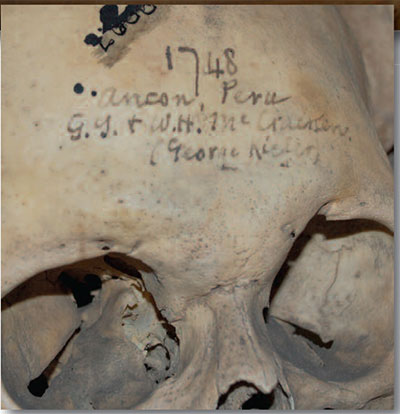
- “A Historical Osteobiography of the African Crania in the Morton Collection”
- “Orsa: The Open Research Scan Archive”
- “The Morton Collection and NAGPRA”
Brace, C. Loring. “Race” is a Four-Letter Word. New York: Oxford University Press, 2005.
Douglass, Frederick. The Life and Writings of Fredrick Douglass. New York: International Publishers, 1850.
Erickson, Paul A. “Morton, Samuel George (1799–1851),” in History of Physical Anthropology: An Encyclopedia, edited by Frank Spencer, pp. 689-90. New York: Garland, 1997.
Fabian, Ann. “The Curious Cabinet of Dr. Morton,” in Acts of Possession: Collecting in America, edited by L. Dilworth, pp. 112-37. New Brunswick, NJ: Rutgers University Press, 2003.
Gould, Stephen J. The Mismeasure of Man. New York: Norton, 1981.
Meigs, James Atkin. A Memoir of Samuel G. Morton. Philadelphia, PA: Collins, 1851.
Morton, Samuel G. Catalogue of Skulls of Man and the Inferior Animals in the Collection of Samuel George Morton. 3rd edition. Philadelphia, PA: Merrihew & Thompson, 1849.
Michael, John S. “A New Look at Morton’s Craniological Research.” Current Anthropology 29-2(1998):349-54.
Smedley, Audrey. Race in North America: Origin and Evolution of a Worldview. Boulder, CO: Westview, 1993.
Stanton, William R. The Leopard’s Spots: Scientific Attitudes toward Race in America, 1815–1859. Chicago, IL: University of Chicago Press, 1960.
Stocking, George. Race, Culture, and Evolution. New York: Free Press, 1968.
